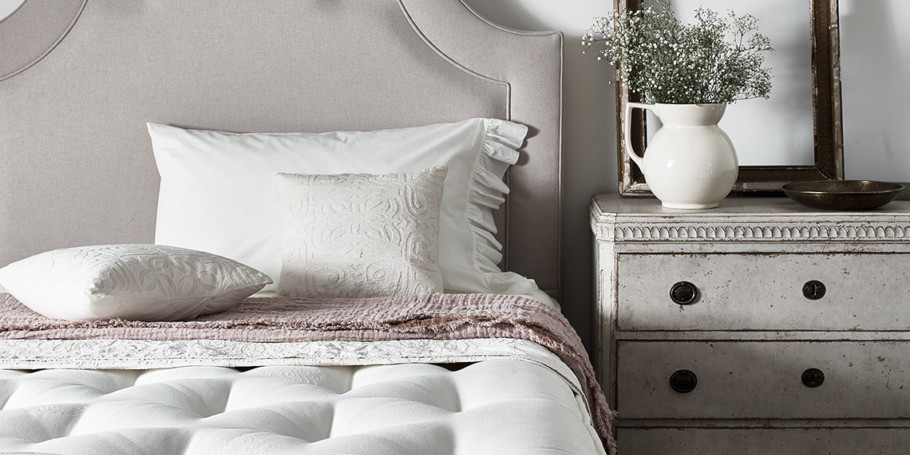Mattress Care Guide
Your new Harrison Spinks mattress is an investment and the first step towards healthier, restorative sleep. Please take the time to read this care guide in order to understand which type of mattress you have purchased and how to look after it.
Delivery
A Harrison Spinks pocket spring mattress is heavy, always use 2 people to handle the product. Take care when lifting to avoid personal injury and/or damage to the mattress. Seek assistance to move, turn and rotate the mattress, using the handles to do so, but not for lengthy carrying. After unwrapping your new mattress, leave it in a well ventilated room for a few hours. Any natural scent from the fillings will dissipate after a few days.
Dimensions
Each and every one of our mattresses are handmade to metric dimensions meaning they will naturally vary a little in size. A variation of +/- 2cm is in line with BS1334:1996. During transportation some mattresses may contract, but they will relax to their normal length again after being used for a short while.
Tufting
All of our mattresses have tufts that ensure the upholstery layers remain firmly in place. In the unlikely event of any of your tufts snapping, contact the retailer from whom you purchased your mattress. They’ll arrange to have the tuft replaced in your home.
General advice
- Do not fold or roll your mattress as this could damage it.
- Avoid jumping on your mattress, as this could damage the springs and the base. Electric blankets can be used in conjunction with all Harrison Spinks mattresses.

Caring for your new mattress
Mattress protection
We highly recommend using an under blanket or good quality cotton or wool-faced mattress protector. It’s a good idea to air the mattress regularly too, by leaving duvets folded back for a few hours each day.
Cleaning
Remove dust from your mattress every few months using a soft brush. Never use a vacuum cleaner, even if you have a specific mattress attachment, as this can displace the natural fillings. Any spillages should be absorbed using a dry cloth or paper towels. If you need to sponge the mattress, use a damp cloth and a very mild solution of soap and water.
Supportive base
If you are using your new mattress on your own bed, it’s important that the base is in good condition. The mattress will contour to it, just as it does with your body, so we recommend replacing an old base. If the base is damaged in any way, it could be detrimental to your mattress. If your mattress is being placed on a slatted base, ensure the gaps are no more than 75mm apart. If they are, you should consider using a baseboard or under mattress – your retailer can provide further advice.

Body impressions
Expect impressions
As most people sleep in the same position every night, body impressions are a normal feature of handmade mattresses. You may find fillings settle or dip in the area where you sleep which can leave a ridge in the centre of the mattress. Just like the impressions that form on the insole of leather shoes, this is simply your mattress “getting to know you”.
Reducing impressions
We recommend following our rotating and turning instructions to minimise body impressions. Please note: our mattresses are extremely heavy. If you are unable to rotate and turn your mattress, with continued use, fillings will settle of their own accord, however this take considerably longer.
Rotating or turning?
Check the label on the surface of your mattress for the following wording to determine which type of mattress you will be caring for:
- Non-turn/rotate only/single sleeping surface/pillow top mattress
- Turnable/turn with the seasons/
dual sleeping surface mattress
Our non-turn mattresses can also be identified by the use of a non-sleeping surface sticker on the underside.

Rotating your non-turn mattress
If your mattress label states non-turn / rotate only / single sleeping surface / pillow top, we recommend rotating your mattress regularly during the first few months and about twice a year thereafter.
Note: If you struggle to rotate your mattress, do not worry, this is only a recommendation
to help reduce body impressions.

Step 1
Push the mattress at opposite corners A and B whilst it’s laying at.
Step 2
Push on alternate corners A and B to position the mattress on the bed.
Done!
All done. Your mattress has now been rotated end to end.
Non-turn Zip & Link mattresses - Unzip your mattresses and rotate them both together through 180 degrees, without turning them.
One piece dual firmness mattresses (without Zip & Link) - Rotating your dual firmness mattress will mean you and your partner will need to swap sleeping sides to maintain firmness preferences.
Turning your turnable mattress
If your mattress is turnable or seasonal turn, we recommend turning and rotating your mattress regularly during the first few months and about twice a year thereafter. A good way to remember to turn your mattress is when the clocks change in the spring and autumn.
Note: If you struggle to turn and rotate your mattress, do not worry, this is only a recommendation
to help reduce body impressions.

Step 1
Rotate the mattress to overhang the bed.
Step 2
Raise the mattress up on its edge.
Step 3
Lower the mattress gently to expose the other side.
Step 4
Realign the mattress with the bed.
Turning Zip & Link mattresses - Unzip your mattresses to turn and rotate them both together.
One piece dual firmness mattresses (without Zip & Link) - To maintain your normal sleeping side, turn the mattress over from head to foot only.

